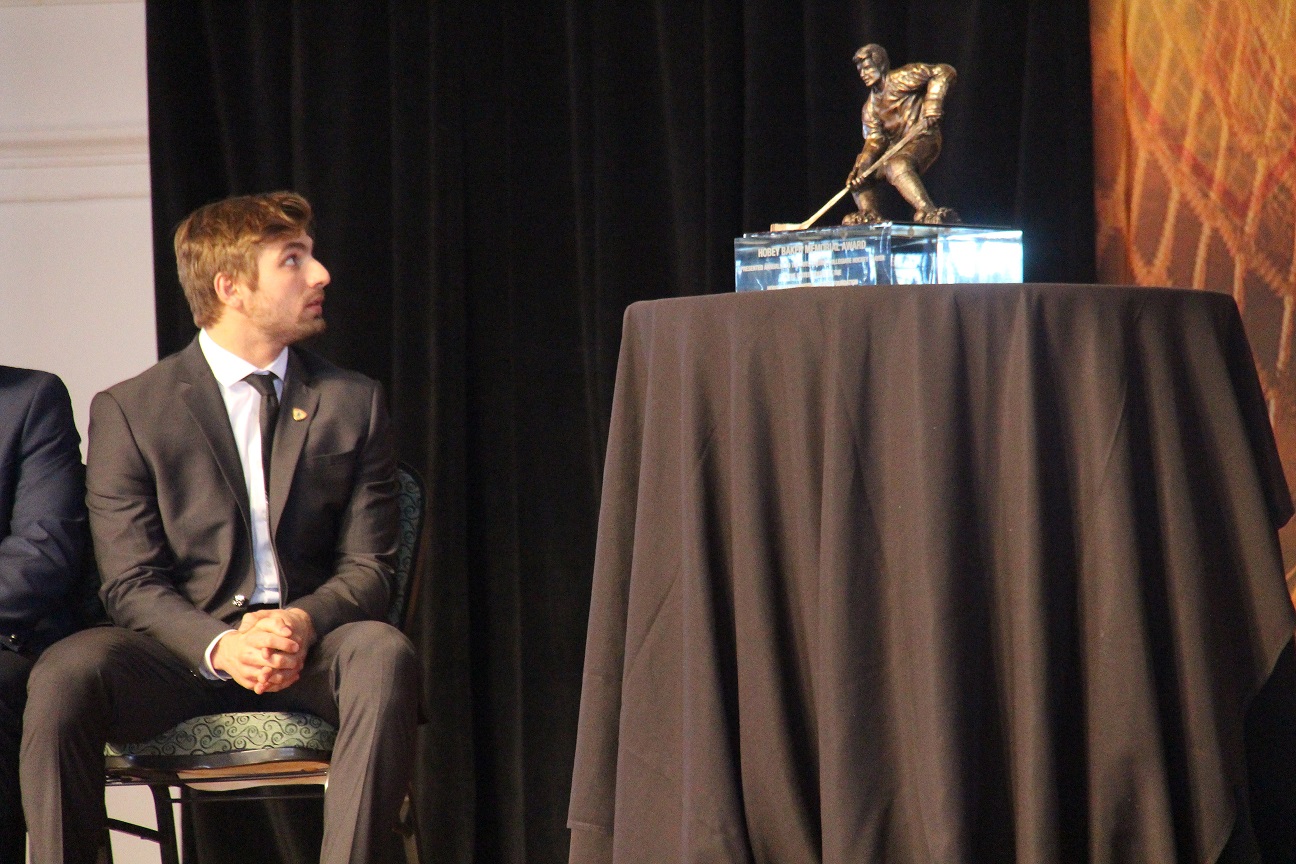By Dan McLoone
CHICAGO – As was the case for much of the season for Zach Aston-Reese and Northeastern, a promising start did not translate into a desirable finish. Sitting up on stage in the Aon Grand Ballroom, Aston-Reese watched as defenseman Will Butcher of the University of Denver was awarded the 37th Hobey Baker Award, a recognition that he was one of the three finalists for.
Butcher is certainly a deserving winner, helping Denver to the NCAA title game on Saturday night, but many at Northeastern thought that this was the moment Aston-Reese would receive the award recognizing the nation’s top player. The Huskies may not have lived up to the hype that saw them ranked second in the Hockey East preseason poll, but the senior forward and Pittsburgh Penguins signee shattered all expectations that anyone had for him coming into the year, posting one of the strongest statistical seasons in program history and establishing himself as an individual force.
While the disappointment may be palpable, Husky fans shouldn’t diminish the magical season their assistant captain posted. Instead, they should take a step back and applaud him for what it was: the culmination of a phenomenal four years on Huntington Avenue that transformed Aston-Reese as a player and the identity of the entire Northeastern program as a whole.
There was plenty of hype surrounding Jim Madigan’s eleven freshman recruits in 2013, and most of them gave Northeastern fans plenty to be excited about for the future. But if someone told you that one member of that freshman class would go on to become just the second Hobey Hat Trick finalist in program history, smart money probably wouldn’t have been on Aston-Reese.
Matt Benning, Dalen Hedges, and John Stevens all impressed during their debut seasons, while Mike Szmatula looked like a budding future star after posting 15 goals and 24 assists. But hidden behind these other players that looked to be part of a bright future in Boston was a six-foot winger from Staten Island.
Aston-Reese tallied just eight goals and 11 assists during his debut campaign, but as many of his classmates transferred or left the program over the next few years, Aston-Reese doubled down on his commitment. Benning went pro after helping the Huskies win the Hockey East Championship. Szmatula transferred to Minnesota. Hedges succumbed to injuries and left the program.
In an up-and-down season for the Huskies, Aston-Reese did everything he could to carry the team to the finish line.
But amidst all the change, Aston-Reese continued to improve. He upped his scoring during his sophomore season, finishing with 23 points despite playing in four fewer games. It was during his junior year, however, when he finally blossomed.
When early-season struggles led Madigan to tinker with his lines, he unlocked a top three that would terrorize opposing defenses for two years. Paired with John and Nolan Stevens, Aston-Reese posted 29 assists, nearly tripling his total of 10 from the previous campaign, as he developed as a distributor. He added 14 goals and learned to cut down on silly stick penalties that kept him on the bench in key moments during his first two seasons, becoming a crucial member of both the Northeastern penalty kill and power play units.
When the dust had settled after the Huskies made their improbable run to the Hockey East crown in 2016, Aston-Reese, like many of his teammates, had to make an important decision on his future at Northeastern. The core of the defending Hockey East champions could have been absolutely decimated, with Kevin Roy graduating and the potential early losses of Benning, Aston-Reese, and the Stevens brothers. But coming back was an easy choice if it meant another season of that top forward line that had already clicked.
Unfortunately, 2017 did not play out as Aston-Reese or the Stevens brothers envisioned in that regard. Injuries kept the brothers off the ice for significant chunks of the season, forcing Madigan to once again mix and match his offensive lines.
But he never had to worry about Aston-Reese’s offensive production. In fact, Madigan frequently moved guys who were struggling to find the back of the net up to skate with ZAR. Lincoln Griffin could use a spark? Let’s throw him up with Reeser. Sam Kurker needs to get it going? Put him on ZAR’s line. Matt Filipe needs to be more consistent? 12 can help him out.
In an up-and-down season for the Huskies, Aston-Reese did everything he could to carry the team to the finish line. Dylan Sikura and Adam Gaudette both submitted phenomenal seasons and were a big part of the offensive success that Northeastern enjoyed, but when the team needed the big goals, it was Aston-Reese who would deliver. His 31 goals were tops in the nation, while his 63 total points were tied for first. He fittingly climbed to 12th place on the school’s career records for both goals and points while scoring at such a fast pace that most of the nation was chasing him the entire year.
Winning the Hobey Baker Award would have immortalized Aston-Reese in Northeastern lore forever. But, much like the story of the season for Northeastern, giving everything he had just wasn’t quite good enough to separate him from the pack. Even though he didn’t leave Chicago with any hardware, Aston-Reese can return to his new professional career in Wilkes-Barre content with his accolades: assistant captain, NCAA scoring leader, Hockey East Player of the Year, Hobey Baker finalist, Hockey East Champion. Damn good hockey player.


